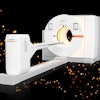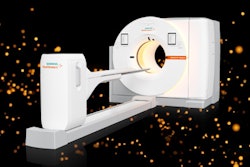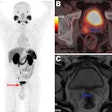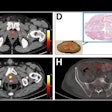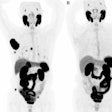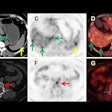A new PET radiotracer for imaging prostate cancer met its primary endpoints in a phase II/III clinical trial and promises to bolster the array of available imaging agent for diagnosing the disease, according to a study published June 4 in the Journal of Nuclear Medicine.
Named GuideView, the trial was conducted between September 2021 and October 2023 across 16 sites in Europe and one site in the U.S. and included 172 with newly diagnosed, untreated, high-risk prostate cancer, noted lead author Andrei Iagaru, of Stanford University in Stanford, California, and colleagues.
“Both coprimary endpoints were met, supporting that F-18 CTT1057 can be added to the armamentarium of [prostate-specific membrane antigen]-targeted PET tracers, thus increasing patient access to proper diagnosis and tailored [prostate cancer] treatment,” the group wrote.
The latest National Comprehensive Cancer Network Clinical Practice Guidelines in Oncology for prostate cancer recommend PSMA-PET as an effective frontline imaging technique for detecting primary lesions. Gallium-68 PSMA-11 was the first such tracer approved, followed by F-18-labeled PET radiotracers, including F-18 DCFPyL (Pylarify) and F-18 rhPSMA-7.3 (Posluma).
F-18 labeled tracers offer the benefits of more scalable batch production than gallium-68-labeled radiotracers, and their longer half-life enables delayed PET acquisition. Imaging with PSMA-targeted PET radiotracers also helps select patients who may benefit from radiopharmaceutical therapy, such as lutetium-177 PSMA-617 (Pluvicto), the authors noted.
However, wider availability of effective and accurate PET radiotracers is required, since patient access to these imaging modalities is inadequate in certain geographical regions, they added.
In the GuideView trial, 172 patients received injections of F-18 CTT1057 and then underwent PET/CT scans 90 minutes later. Three independent readers visually evaluated the images. Coprimary endpoints were patient-level sensitivity and region-level specificity for detection of PSMA-positive lesions, with histopathology as the standard of truth.
![Representative F-18 CTT1057 PET/CT scan case showing true-positive lesions in primary tumor (PT) and pelvic lymph nodes (PLNs) metastases in 63-y-old patient (PT clinical stage 3; Gleason score, 9 [4 + 5]; PSA, 14.2 ng/mL). Axial slices (left to right) show fused PET/CT scan, PET scan, and CT scan. (A) True-positive lesions in left prostate gland (SUVmax, 14; blue arrows). (B–E) True-positive lesions were seen in several PLNs (red arrows). (B) Right external iliac (SUVmax, 4.7). (C) Right internal iliac (SUVmax, 6.9) and left external iliac (SUVmax, 11.4). (D) Left external iliac (SUVmax, 10.2). (E) Presacral (SUVmax, 3.6). HU = Hounsfield units.](https://img.auntminnie.com/mindful/smg/workspaces/default/uploads/2025/06/f3large-1.xj1ZOZZQIn.jpg?auto=format%2Ccompress&fit=max&q=70&w=400) Representative F-18 CTT1057 PET/CT scan case showing true-positive lesions in primary tumor (PT) and pelvic lymph nodes (PLNs) metastases in 63-y-old patient (PT clinical stage 3; Gleason score, 9 [4 + 5]; PSA, 14.2 ng/mL). Axial slices (left to right) show fused PET/CT scan, PET scan, and CT scan. (A) True-positive lesions in left prostate gland (SUVmax, 14; blue arrows). (B–E) True-positive lesions were seen in several PLNs (red arrows). (B) Right external iliac (SUVmax, 4.7). (C) Right internal iliac (SUVmax, 6.9) and left external iliac (SUVmax, 11.4). (D) Left external iliac (SUVmax, 10.2). (E) Presacral (SUVmax, 3.6). HU = Hounsfield units.Journal of Nuclear Medicine
Representative F-18 CTT1057 PET/CT scan case showing true-positive lesions in primary tumor (PT) and pelvic lymph nodes (PLNs) metastases in 63-y-old patient (PT clinical stage 3; Gleason score, 9 [4 + 5]; PSA, 14.2 ng/mL). Axial slices (left to right) show fused PET/CT scan, PET scan, and CT scan. (A) True-positive lesions in left prostate gland (SUVmax, 14; blue arrows). (B–E) True-positive lesions were seen in several PLNs (red arrows). (B) Right external iliac (SUVmax, 4.7). (C) Right internal iliac (SUVmax, 6.9) and left external iliac (SUVmax, 11.4). (D) Left external iliac (SUVmax, 10.2). (E) Presacral (SUVmax, 3.6). HU = Hounsfield units.Journal of Nuclear Medicine
According to the analysis, both coprimary endpoints were met, with patient-level sensitivity (range, 86.8% to 90%) and region-level specificity (97.1%; lower-bound 95% CI, 92.7%) surpassing the success criteria for all three readers, the researchers reported. In addition, agreement between readers on cases was high (63.9%) and intrareader reproducibility was almost perfect, they added.
“GuideView provides evidence of the efficacy of F-18 CTT1057 PET/CT as a molecular imaging biomarker for the detection of PSMA-positive lesions against histopathology in patients with [prostate cancer] before initial curative therapy,” the group wrote.
Ultimately, F-18 CTT1057 is being developed along with a treatment molecule (lutetium-177-labeled CTT1403) as a theranostic pair to diagnose and treat tumors that express PSMA, with the goal of expanding treatment options for patients.
“F-18 CTT1057 will contribute to expanding access to PSMA-PET imaging to properly diagnose and treat patients with [prostate cancer],” the group concluded.




